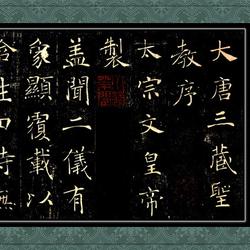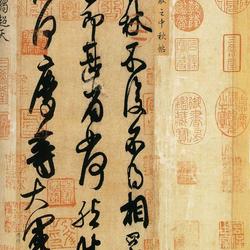The only ink written by Suo Jing discovered so far, "Ode to the Beginning of the Master"
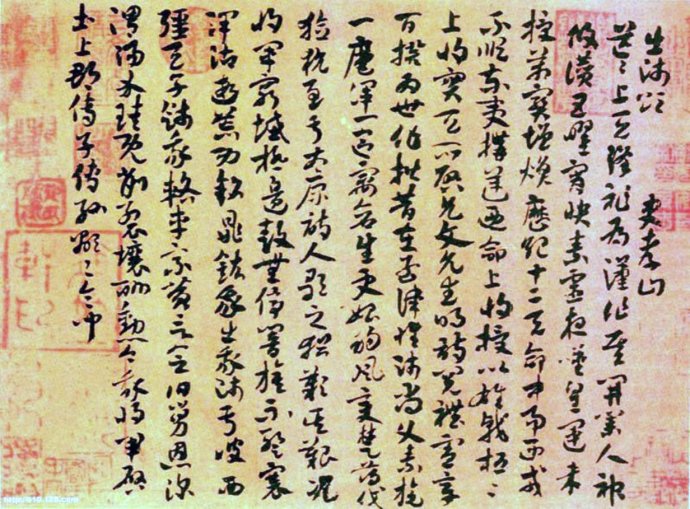
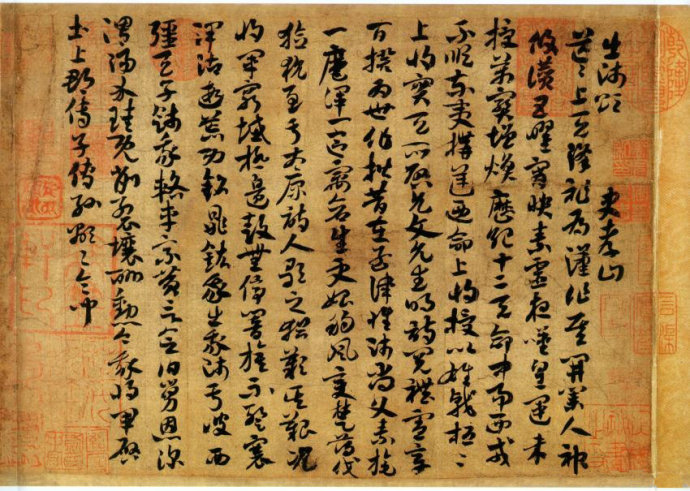
Volume "Ode to Become a Master" written by Suo Jing, paper, cursive script, length 21.2cm, width 127.8cm.
Suo Jing was a famous calligrapher in the Jin Dynasty. "Xuanhe Calligraphy" records that Suo Jing had outstanding talent when he was young. Suo Jing's calligraphy was famous for his Zhangcao calligraphy. His calligraphy is "like the wind lifting up, like a bird of prey taking flight, like a solitary pine in the snowy mountains, or the dangerous rocks in the glacier", which is very dangerous and powerful. Suo Jing occupies a high position in the history of Chinese calligraphy. Historians say his calligraphy is "similar to that of Xi (Wang Xizhi) and Xian (Wang Xianzhi)", and "Ode to the Master" is his only remaining masterpiece.
"Ode to the Master" is the only ink mark of Suo Jing discovered so far. This work has been circulating in an orderly manner since the Tang Dynasty. In 1922, the abdicated Qing Emperor Pu Yi took the volume out of the palace in the name of a reward to Pu Jie. It was lost among the people after 1945.
Explanation of "Ode to the Master":
The vast sky descends Zuo to the Han Dynasty to establish the foundation and open the business. People and gods praise each other. The five rays shine at night.
Su Ling sighs at night, the emperor’s luck has not been granted, the treasures are brightening, the twelve years of history are destined to change.
The Western Rong were disobedient and the Eastern barbarians rebelled. The general was ordered to confer a male halberd to General Huan Huan.
Inspired by the heaven, allowed by the text and the military, read the poems and rituals of the Ming Dynasty, chartered by Bai Kui, and set a standard for the world.
In the past, when I was in Mengjin, I was the only master who respected my father. Su Yan lived under his command in Hun District, and the people began to change.
The wind changes the state of Chu, and the lynxes are hunted down. As for Taiyuan, the poet still sighs at the difficulty when he sings about it.
General Kuang, at the extreme end of the restricted area, the drums never stop ringing, the flag never wavers (the upper left part of the character is "car"), Hunyu is in the wilderness, the merits are inscribed with Dinghong (remove the cover and add gold on the right)
I left my division and went to the western frontier. The emperor gave me a farewell. I rode in a chariot in the Yellow River. I remembered my old work.
My kindness to Weiyang has been cut, and the soil has been split to reward the honor. Now I am the general, and I am going to the county.
The news of Sun Xianxian's order passed down from his descendants
"Ode to the Master" has been circulating in an orderly manner since the Tang Dynasty. In the Tang Dynasty, it was collected by Princess Taiping. In the Song Dynasty, it was collected by the palace during the Shaoxing period. In the Ming Dynasty, it was collected by the famous collector Wang Shimao. Emperor Qianlong once included it in the "Sanxitang Dharma Tie". In 1922, the abdicated Qing Emperor Pu Yi took the volume out of the palace in the name of rewarding Pu Jie, and it was lost among the people after 1945. In July 2003, it suddenly appeared at China Guardian's 2003 spring auction, causing an uproar in the industry.
This piece has no title. There are 22 collection seals, including: the Sanskrit seal of Princess Taiping of the Tang Dynasty "San Miao Mu Tuo", the seal of "Yue" and "Shao Yue's Seal" by Li Yue of Tang Shao King, and the "Eternal Preservation Secret" of Tang Zhongshu Shilang Wang Ya (two seals) Department); Song Gaozong's "Shao" and "Xing" (Lianzhu Seal), Song Neifu's "Shu Seal" (half seal) and "Inner House Secretary's Seal"; the "Li Lixuan Seal" and "Eternal Dynasties Yong Seal" of the people before the Ming Dynasty "Bao", "Liu Clan's Zhongshou", "Liu Wan's Private Seal", "Anyuan Zhong Seal" and two seals with indistinguishable text; Qing Anqi's "Yi Zhou Collection", Qing's Inner Palace "Qianlong's Imperial Treasure", The seals include "Shiqu Baoji", "Leshou Hall Appreciation Treasure", "Qianlong Appreciation", "Sanxi Hall Jingjian Seal" and "Yi Zisun".
The postscript of Mi Youren of the Song Dynasty on the later paper reads: "Ode to the Master on the right, written by Xian of the Sui Dynasty, approved by Mi Youren on April 7, 9th year of Shaoxing." On the lower right is the seal of the Doctor of Supervision of Calligraphy and Painting. There are 6 seals on the left, including: "Wu" (half seal), "□Xuan", "□□ Shanmu", "Guxi Emperor", "Shou" and one seal with indiscernible text. There are 6 collection seals on the right, which are "Treasure of the Zhou Family of Anyi", "Treasure of the Five Blessings and Five Dynasties", "Treasure of the Bazheng Cang Nian", "Treasure of the Imperial View of Jiaqing", "Appreciation of Xuantong", and "Essence of Wuyi Zhai". "Jianxi".
It is preceded by the two characters "Jin Mo" in seal script and the monogram "五", and is stamped with the seal "Yu Fu Shu". According to the stamp and seal, the predecessors determined it to be the book of Emperor Gaozong of the Song Dynasty, but it was actually imitated by the Ming Dynasty. There are also seals from the Imperial Household of the Qing Dynasty: "Tai Shang Emperor", "Shiqu Ding Jian", "Bao Ji Re-edited", and "Ningshou Palace continues to include Shi Qu Bao Ji". On the upper left is a paragraph inscribed by Emperor Qianlong Guisi (38th year, 1773).
The seals on the front of the collection across the water include: Ming Dynasty Wang Shimao's "Book Collection of Langya King Jingmei", Qing Anqi's "An" and "Yi Zhou Jiantang", Qing Neifu's "Ba Zheng Cang Nian Treasure". Later, across the water, there was an imperial inscription of Emperor Qianlong's reign (13th year, 1748), with the seals of "Qian" and "Long", and the Qing'an Qijianzang seal "Lucun".
This book is recorded in: Ming Dynasty Zhan Jingfeng's "Dongtu Xuanlan", Wang Shizhen's "Yanzhou Mountain Man's Continuation", Wu Qizhen's "Wu Family Calligraphy and Painting Notes", Sun Kuang's "Calligraphy and Painting Postscript", Qing Dynasty Gu Fu's "Life" "Spectacular", An Qi's "Mo Yuan Hui Guan", Wu Sheng's "Daguan Lu", "Shiqu Baoji Continuation: Ningshou Palace", Ruan Yuan's "Shiqu Essays", Sun Yuebian's "Peiwenzhai Calligraphy and Painting Manual", Ni Tao's " "Six Arts One Record" and other books. Engraved into "Sanxitang Dharma Notes".
According to the bibliography and collection seals, this book is called the "Shaoxing version" of "Ode to the Master". According to Mi Youren's postscript, it is mostly attributed to the Sui Dynasty. It is also believed to be written by Suo Jing of the Western Jin Dynasty or Liang Xiao Ziyun of the Southern Dynasty, or even by the Tang Dynasty. The general circulation situation is as follows: in the Tang Dynasty, it was collected by Princess Taiping, Li Yue and Wang Ya successively; in the Shaoxing period of the Southern Song Dynasty, it entered the inner palace; in the Ming Dynasty, it returned to Wang Shimao; in the early Qing Dynasty, it was collected by An Qi and later entered the inner palace of Qianlong; in the eleventh year of the Republic of China (1922) On the ninth day of the lunar month, Pu Yi took it out of the palace in the name of rewarding Pu Jie. After 1945, it was scattered and hidden among the people for more than 60 years. In 2003, it was acquired by an auction company and the Palace Museum bought it back with a huge sum of money.
"Ode to the Master" as a well-circulated chapter and ink ink has been preserved in two copies, one is the "Shaoxing version" and the other is the "Xuanhe version". The latter was once included in the Northern Song Dynasty. It has the title of "Conquering the West Sima Suo" by Emperor Huizong of the Song Dynasty. Jingshu" and "Xuanhe" ladle seals are generally identified as Suojingshu of the Western Jin Dynasty, and some are also believed to be Liang Xiaoziyun's. It is recorded in "Shigutang Calligraphy and Painting Collection" and other books. The general situation of its circulation is as follows: it entered the Xuanhe inner palace in the Northern Song Dynasty, and seemed to be transferred from Yansong's family to Wenpeng's hands in the Ming Dynasty. It was later sold to Xiang Yuanbian and disappeared after entering the Qing Dynasty. The "Xuanhe Edition" was engraved in Dong Qichang's "Xihongtang Tie", and Wang Kentang's "Pomo Zhai Tie" was also copied. Today, only the rubbings of Fa Tie remain.
绍兴本《出师颂》本无名款,后人认为是西晋索靖或南朝梁·萧子云作,或谓隋贤或唐人书,并无定论。从本幅中有唐太平公主、李约、王涯等人鉴藏印看,书写不会晚于初唐。据宋·米友仁跋定为“隋贤书”当较可信。此书属较典型的早期章草书体,“蚕头凤尾”带有隶书遗痕,“银钩虿尾”具草书特征,整体书风规整而不失变化,劲健中见自然飞动之势,古朴又典雅,是六朝以来创立规范章草的传统体貌,唯稍增飘逸之势,与隋·智永《真草千字文》中的草体大致相近。故定为隋人书是合宜的。
索靖集评:
齐王僧虔:张芝、索靖、韦诞、钟会、二卫并得名前代,古今既异,无以辨其优劣,惟见笔力惊绝耳。(《论书》)
齐 王僧虔:索靖字幼安,敦煌人,散骑常侍张芝姊之孙也。传芝草而形异,甚矜其书,名其字势曰银钩虿尾。(《又论书》)
梁 袁昂:索靖书如飘风忽举,鸷鸟乍飞。(《古今书评》)
唐 张怀瓘:崔瑗善章草……索靖乃越制特立,风神凛然,其雄勇劲健过之也。(《书断》)
唐 张怀瓘:引羊欣云:张芝、皇象、锺繇、索靖,时并号“书圣”。(《书断》)
唐张怀瓘:引王隐云:靖草绝世,学者如云,是知趣皆自然,劝不用赏。时人云:精熟至极,索不及张;妙有余姿,张不及索。(《书断》)
唐 房玄龄:靖与尚书令卫瓘俱以善草书知名,帝爱之。瓘笔胜靖,然有楷法,远不能及靖。(《晋书 列传第三十》)
宋 姜夔:大凡学草书,先当取法张芝、皇象、索靖章草等,则结体平正,下笔有源。(《续书谱》)
元 刘有定:索靖与卫瓘及其子恒俱学于张伯英。瓘自言我得伯英筋,恒得伯英骨,靖得伯英肉。(《衍极注》)
清 宋曹:卫瓘得伯英之筋,索靖得伯英之骨。(《书法约言》)
清钱泳:北派由锺繇、卫瓘、索靖及崔悦、卢谌、高遵、沈馥、姚元标、赵文深、丁道护等,以至欧阳询、颜真卿、柳公权。(《书学》)
清阮元:《唐书》称询始习王羲之书,后险劲过之,因自名其体;尝见索靖所书碑,宿三日乃去。夫《唐书》称初学羲之者,从帝所好,权词也;悦索靖碑者,体归北派,微词也。盖锺、卫二家,为南北所同,托始于索靖,则惟北派祖之,枝干之分,实自此始。(《南北书派论》) 清 阮 元:崔悦与范阳、卢谌齐名,谌法锺繇,悦法卫瓘,而俱习索靖之章皆尽其妙。(《南北书派论》)
清 包世臣:草书唯皇象、索靖笔鼓荡而势峻密,殆右军所不及。(《艺舟双楫》)
清包世臣:《索靖传》云:“靖与卫瓘俱以草书知名,瓘笔胜靖,然有楷法,远不能及靖。”始知作草如真,乃汉、晋相承草法,吴郡传衣未远,非由冥悟。余前读《晋书》,于此章句,视为词藻,心镜不明,目精遂眯。是以释子传法,名曰“证盟”法必心悟,非有可传;不得真证,难坚信受。余今日则不啻亲承狮子吼也。欢喜赞叹,并记于后,以吿天下后世之同此志者。(《艺舟双楫》) 清 刘熙载:索幼安分隶,前人以韦诞、锺繇、卫瓘比之,而尤以草书为极诣。其作《草书状》云:“或若倜傥而不群,或若自检其常度。”惟倜傥而弥自检,是其所以真能倜傥与?索靖书如飘风忽举,鸷鸟乍飞,其为沈著痛快极矣。论者推之为北宗,以欧阳信本书为其支派,说亦近是。然三日观碑之事,不足引也。(《艺概》) 清 刘熙载:西晋索靖、卫瓘善书齐名。靖本传言:“瓘笔胜靖,然有楷法,远不及靖。”此正见论两家者不可觭为轻重也。瓘之书学上承父觊,下开子恒,而靖未详受授。(《艺概》)
清刘熙载:书有振、摄二法。索靖之笔短意长,善摄也;陆柬之之节节加劲,善振也。(《艺概》)
清 周星莲:昔有人问索靖笔法,索靖以三指执笔,闭目谓之曰:“胆,胆,胆!”(《临池管见》)
清 朱和羹:魏晋去汉未远,故其书点画丝转自然,古意流露。索、卫属一台二妙,二王妙迹,天骨开张。(《临池心解》)
清康有为:王侍中论张芝、索靖、韦诞、锺繇、二卫书“无以辨其优劣,惟见其笔力惊异。”斯论致公。袁昂、梁武、肩吾、怀瓘、嗣真、吕总诸品,必欲强为甲乙,随意轩轾,滋增妄矣。(《广艺舟双楫》) 清 康有为:详观索靖、王导、右军、大令、鲁公草书...巨刃挥天,大刀斫阵,无不以险劲为主,若不得执笔之势,如何能之?(《广艺舟双楫》) 清 康有为:姜尧章最称张芝、索靖、皇象章草,以时人罕及,因力学之。(《广艺舟双楫》)
清 康有为:若欲复古,当写章草,史孝山《出师颂》致足学也。(按:《出师颂》,索靖书。)(《广艺舟双楫》)
索靖(239一303年),西晋书法家。字幼安,敦煌(今甘肃人。张芝姐姐的孙子。官征西司马、尚书郎,封安乐亭侯,谥曰庄。工书法,尤擅章草,传张芝草法而变其形迹,骨势峭迈,富有笔力。前人评谓“精熟至极,索不及张;妙有徐姿,张不及索。”靖亦自重其书,自名其字势力“银钩虿尾”。所书《出师表》很著名。著有《草书状》。善章草书,峻险坚劲,自名曰“银钩蛋尾”。时人云:精熟至极,素不及张:妙有余姿,张不及素。著有《草书状》一篇。

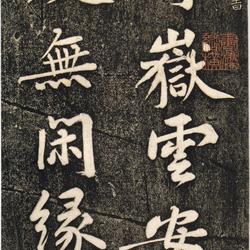
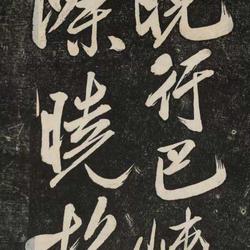
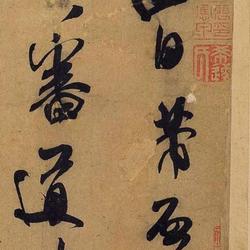
![Mi Fu's pinnacle book Bao Zhao [Fu of Wuhe]--Straightforward and unrestrained regular script reference](https://www.regularcalligraphy.com/uploads/20217/22/thumb_1223c7c1e9cb2b7b.jpg)
